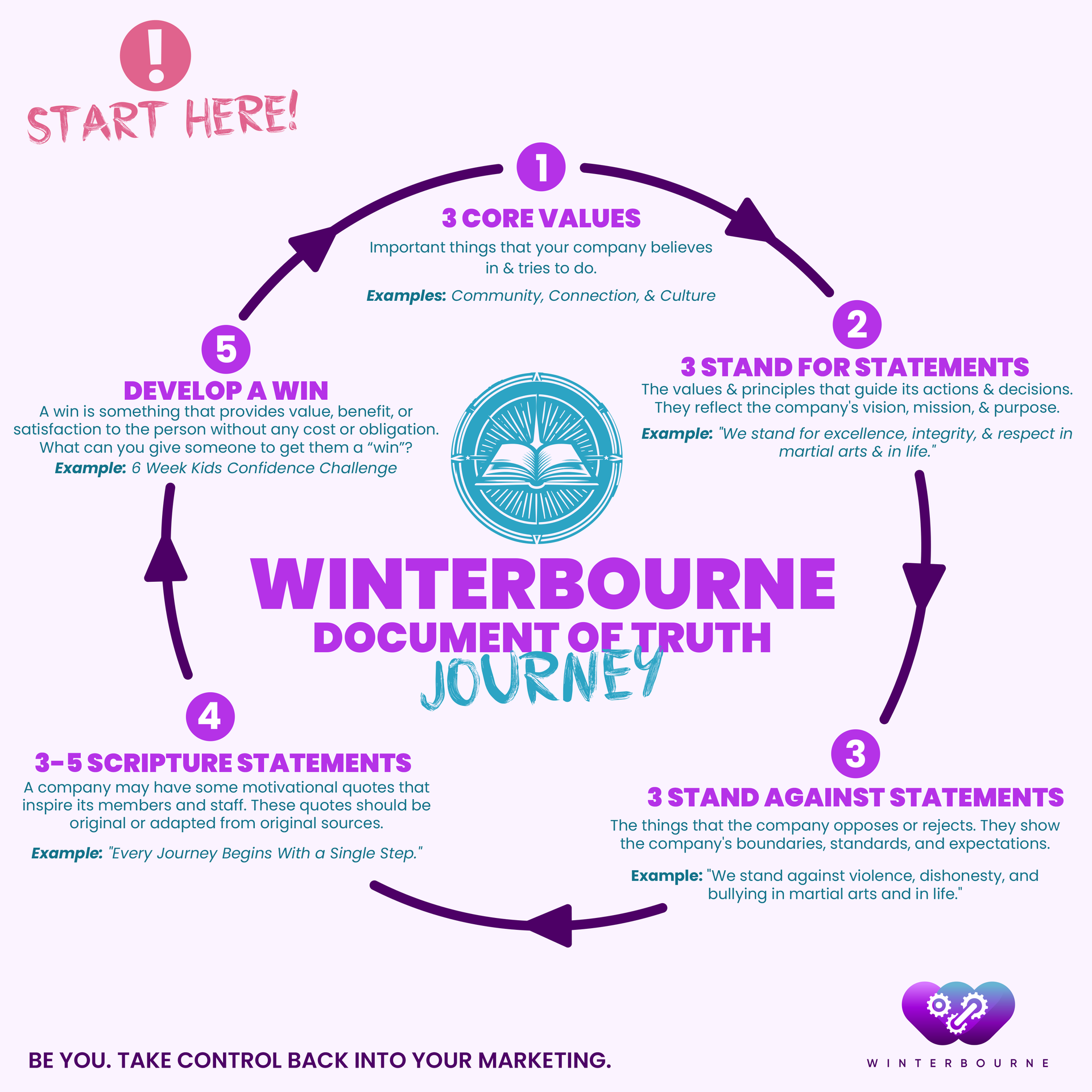
In this blog post, we will explore how martial arts business owners can use the document of truth to develop their belief system.
Understanding the Document of Truth
Explaining the Concept of the Document of Truth
In the world of martial arts business, the Document of Truth is a foundational principle that guides practitioners towards authenticity and integrity. It serves as a comprehensive record of values, beliefs, and objectives that define the essence of a martial arts business.
The Document of Truth is like a map that outlines the core principles and philosophies that a martial arts business stands for. It encapsulates the vision of the organization, its mission statement, and the guiding values that drive every decision and action taken by the business.
Furthermore, the Document of Truth goes beyond mere words on paper; it is a living, breathing document that evolves with the business. It adapts to changes in the industry, customer preferences, and internal dynamics to ensure that the business stays true to its roots while remaining relevant and competitive.
How It Can be Applied to Martial Arts Business
Implementing the Document of Truth in a martial arts business is a transformative process that cultivates a culture of authenticity, transparency, and accountability. By aligning every aspect of the business with its core values and principles, the Document of Truth becomes the compass that guides decision-making and shapes the behavior of employees and stakeholders.
One way the Document of Truth can be applied is through employee training and development. By integrating the core values outlined in the document into training programs, employees are equipped with the knowledge and motivation to embody these values in their interactions with customers and colleagues.
Moreover, the Document of Truth can also influence strategic planning and business development initiatives. When formulating growth strategies, expanding services, or entering new markets, referring back to the Document of Truth ensures that every decision aligns with the business's fundamental beliefs and goals.
Benefits of Using the Document of Truth
- Alignment: The Document of Truth ensures that everyone in the martial arts business is on the same page, working towards common goals and values.
- Authenticity: By grounding all actions in the core principles of the business, authenticity becomes a defining trait of the organization, building trust with customers and stakeholders.
- Accountability: When decisions are guided by the Document of Truth, accountability is heightened as actions are measured against the established values and objectives.
- Growth and Stability: Utilizing the Document of Truth as a benchmark for decision-making fosters sustainable growth and stability, as strategies are rooted in the long-term vision of the business.
Implementing the Document of Truth in Your Business
Creating a Belief System Based on the Document of Truth
Creating a belief system within your business that is based on the Document of Truth is fundamental to establishing a strong foundation for your company culture. The Document of Truth serves as a guiding principle that outlines the core values, mission, and vision of your organization. It defines what your business stands for and what it aims to achieve.
When developing a belief system around the Document of Truth, it is essential to involve key stakeholders such as company leadership, employees, and even customers. By engaging these individuals in the process, you can ensure that the beliefs and values outlined in the Document of Truth are reflective of the collective aspirations and principles of the entire organization.
- Define Core Values: Start by identifying the core values that are most important to your business. These values should encapsulate the fundamental principles that guide decision-making and behavior within the organization.
- Align with Mission and Vision: Ensure that the beliefs outlined in the Document of Truth align closely with your company's mission statement and long-term vision. This alignment will help create a cohesive narrative that inspires and motivates both employees and customers.
- Communicate Effectively: Clearly communicate the beliefs and values of the Document of Truth to all stakeholders. Utilize various communication channels such as company meetings, newsletters, and training sessions to ensure widespread understanding and buy-in.
- Lead by Example: Company leadership should exemplify the beliefs and values outlined in the Document of Truth. Leading by example will help reinforce the importance of these principles and demonstrate their impact on decision-making and actions.
By creating a belief system based on the Document of Truth, your business can foster a culture of integrity, transparency, and accountability that resonates with both internal and external stakeholders.
Incorporating It into Your Business Practices
Once you have established a belief system grounded in the Document of Truth, the next step is to incorporate these principles into your daily business practices. Integrating the Document of Truth into your operations, decision-making processes, and customer interactions can help uphold the core values that define your organization.
- Integrate into Strategic Planning: Ensure that the beliefs outlined in the Document of Truth are integrated into your overall strategic planning process. Align business objectives, goals, and initiatives with these core values to drive consistent decision-making.
- Embed in Employee Training: Incorporate the Document of Truth into employee onboarding and training programs. Educate new hires on the beliefs and values that shape your company culture and provide ongoing guidance on how to apply these principles in their roles.
- Reflect in Customer Interactions: Train your customer-facing teams to embody the beliefs of the Document of Truth in their interactions with clients. Ensure that customer service, sales, and support staff align their behavior and communication with the core values of the organization.
- Measure and Monitor: Establish key performance indicators (KPIs) that reflect the adherence to the Document of Truth in your business practices. Monitor progress, gather feedback, and make adjustments as needed to ensure alignment with the defined beliefs.
By integrating the Document of Truth into your business practices, you can foster consistency, cohesiveness, and authenticity in all aspects of your operations.
Training Your Staff on the Document of Truth
Training your staff on the Document of Truth is crucial to ensure that every employee understands and embodies the core beliefs and values of your organization.
Effective training programs can empower your team to internalize these principles and apply them in their daily roles and interactions.
- Develop Training Modules: Create training modules that educate employees on the history, purpose, and significance of the Document of Truth. Provide context on why these beliefs are essential to the company's success and how they shape the culture.
- Facilitate Interactive Sessions: Conduct interactive training sessions that encourage active participation and dialogue. Create opportunities for employees to discuss how the beliefs of the Document of Truth manifest in their work and share examples of best practices.
- Provide Ongoing Support: Offer continuous support and resources to help employees align their behavior with the principles of the Document of Truth. Mentorship, coaching, and feedback mechanisms can aid in reinforcing these values over time.
- Recognize and Reward: Acknowledge and reward employees who exemplify the beliefs of the Document of Truth in their work. Publicly recognize individuals who embody the core values of the organization and showcase their positive impact on the business.
By investing in comprehensive training on the Document of Truth, you can empower your employees to become ambassadors of your company's values and drive a culture of authenticity and purpose within the organization.
Evaluating the Impact on Your Business
When running a business, it's crucial to assess the effectiveness of your core belief system. By evaluating the impact of your beliefs, you can make informed decisions and drive success within your organization. Let's delve into the key aspects of this evaluation process:
Measuring the Success of Your Belief System
Measuring success starts with defining clear metrics and goals aligned with your belief system. Whether it's customer satisfaction, employee engagement, or financial performance, monitoring these metrics helps gauge the impact of your beliefs on various aspects of your business.
Regularly assess key performance indicators (KPIs) to track the outcomes of implementing your beliefs. Analyze data and feedback to understand the correlation between your beliefs and the results they generate. This evaluation provides valuable insights into the effectiveness of your belief system.
Adjusting and Refining Based on Results
It's essential to be adaptable and open to change when evaluating the impact of your belief system. If the results indicate areas where your beliefs are not yielding desired outcomes, be willing to adjust and refine them accordingly. Embrace feedback, both positive and negative, as it helps you make informed decisions.
Engage with stakeholders, employees, and customers to gather different perspectives on how your beliefs are influencing the business. Use this feedback to iterate on your core beliefs and make necessary adjustments to enhance their impact. Continuous improvement is key to staying relevant and effective in a dynamic business environment.
Sharing the Document of Truth with Your Students
Once you have evaluated the impact of your belief system and made necessary refinements, it's vital to share this document of truth with your team. Transparency and communication are essential in aligning everyone within the organization towards a common goal.
Conduct training sessions, workshops, or meetings to educate your employees about the core beliefs that drive the business. By sharing the document of truth, you empower your team to embody these beliefs in their daily work and decision-making processes. This alignment fosters a cohesive and values-driven culture within your organization.




